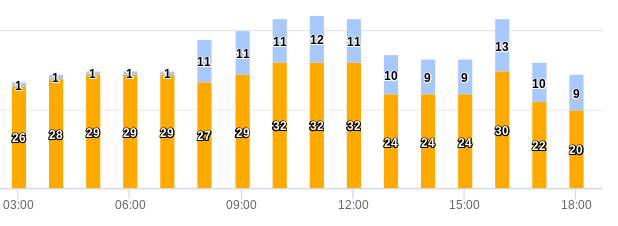How to Identify What Caused a Spike in New Visitors
A big jump in new users can be great news, but you need to understand who these people are and where they come from. Let’s take an example from our Analytics to look how you can break down a recent influx of visitors and gain valuable insight from it.
Here’s a screenshot from our New vs Return Visitor dashboard:
You can see that there was a large spike in First Seen users in the latter half of the month. Let’s zoom in and take a closer look at the time-frame where the spike takes place.
By changing the date range to 5 days, it’s easier to see that the 23rd of January had 17 first seen visitors. That quite a bit more than any other time of the month, so we want to take a look at it in even closer detail. To do that, still in the New vs. Return Visitors report, choose the Date Range and change it to the 23rd for both dates. Then expand the Advanced tab, and set the Show Hourly from No to Yes.
From here we can see that first seen visitors started to appear around 8AM PM, and stayed until 6 PM. Now we can start to compare results to our calendar and see what may have happened. By looking at your programming for the day, you can see if there was an all day event scheduled that day starting around 8am. Community centers will see spikes for things like election polling, new programs, musical guests, or other community events.
How does this help?
If an event at your space is particularly successful at bringing in first seen visitors, there’s a good chance events like this can help grow your community. You might want to run an event like this again if you’re trying to get new patrons into your space.
What if there wasn’t an event on that day?
If you don’t know of a programming reason for why there are so many new devices on your network, there may be a technical one. Adding a new scanning agent to your network will result in all of the devices it’s found showing up as first seen. The way that you can avoid this is by setting up a Shared Privacy Key in the Privacy settings on the agent. Alternatively, you could have had new machines installed that day by your IT department, and all of the equipment is showing up as new.
Understanding First Seen, New, and Return
It’s helpful to understand how First Seen, New, and Return Visitors are calculated. First Seen is what a visitor is labelled the very first day they are seen on the WiFi. New is what a visitor is labelled for the next 30 days that they use the WiFi. And finally, Return is what a visitor is labelled if they visit the library again any time after that.
This is important to understand when you’re first using WhoFi. For the first 30 days that you’re using the system, all of your visitors will be labelled as First Seen or New Visitors. But at around 60 days, the system has had enough visitors come through the space to give numbers that you can use to make programming and other decisions. At around the 60 day mark, WhoFi has also had time to calculate staff devices and network equipment vs real visitors and will filter out the equipment so you can get higher quality insights.
We know that being able to get exact counts on people who visit your space is vital. We are constantly improving our algorithm to ensure that you get quality analytics that help you make informed decisions.



